MB 302 Midterm 2 OSU
1/254
There's no tags or description
Looks like no tags are added yet.
Name | Mastery | Learn | Test | Matching | Spaced |
|---|
No study sessions yet.
255 Terms
Bacteria: Flagella External Structures
Filament, hook, basal body
What does the hook do?
connects the basal body(the motor) to the filament
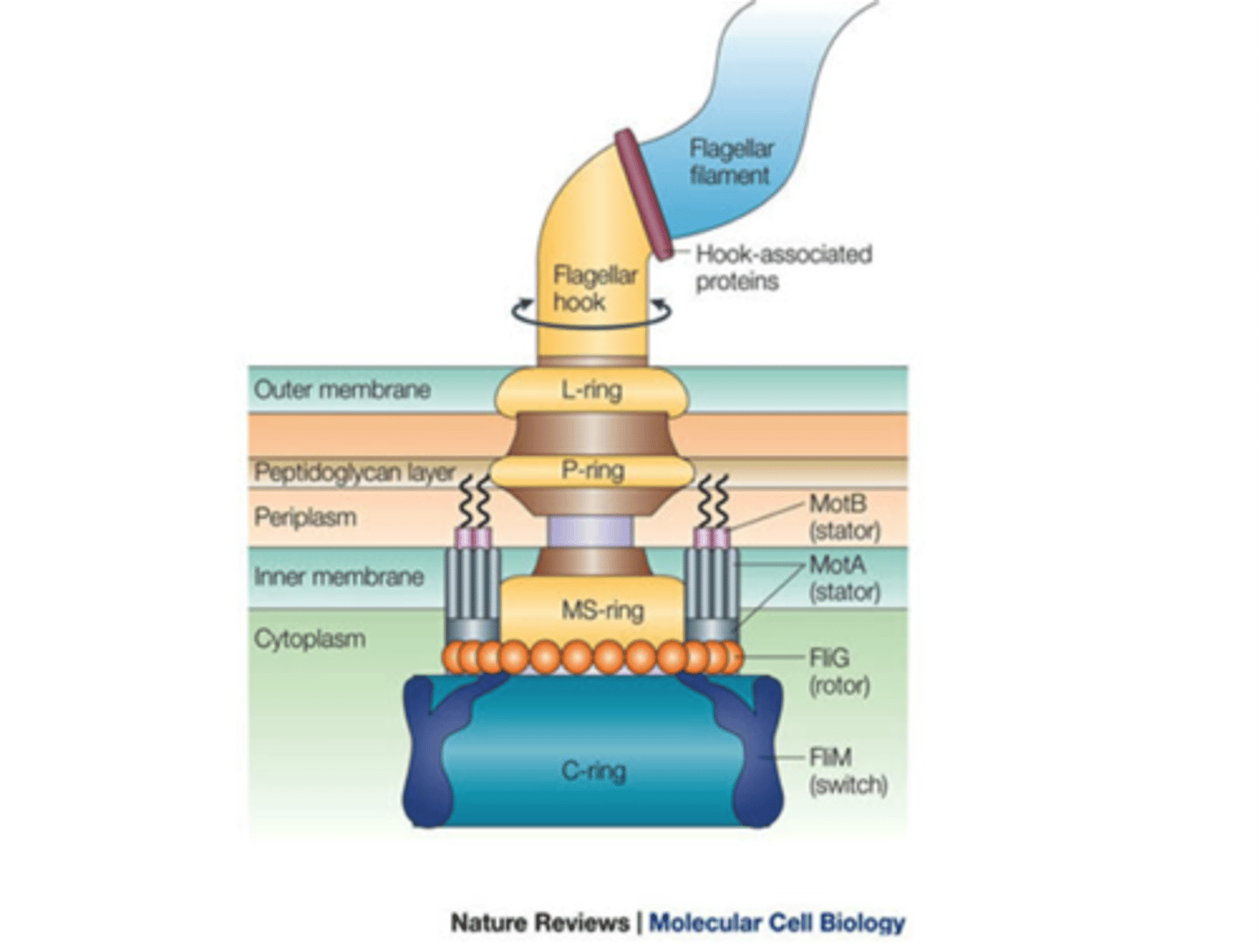
What does the bacteria filament do?
A long thin appendage that extends from the cell's surface. Composed of flagellin and is hallow.
Flagellin protein are transcribed in cell cytoplasm and transported across cell membrane and cell wall.
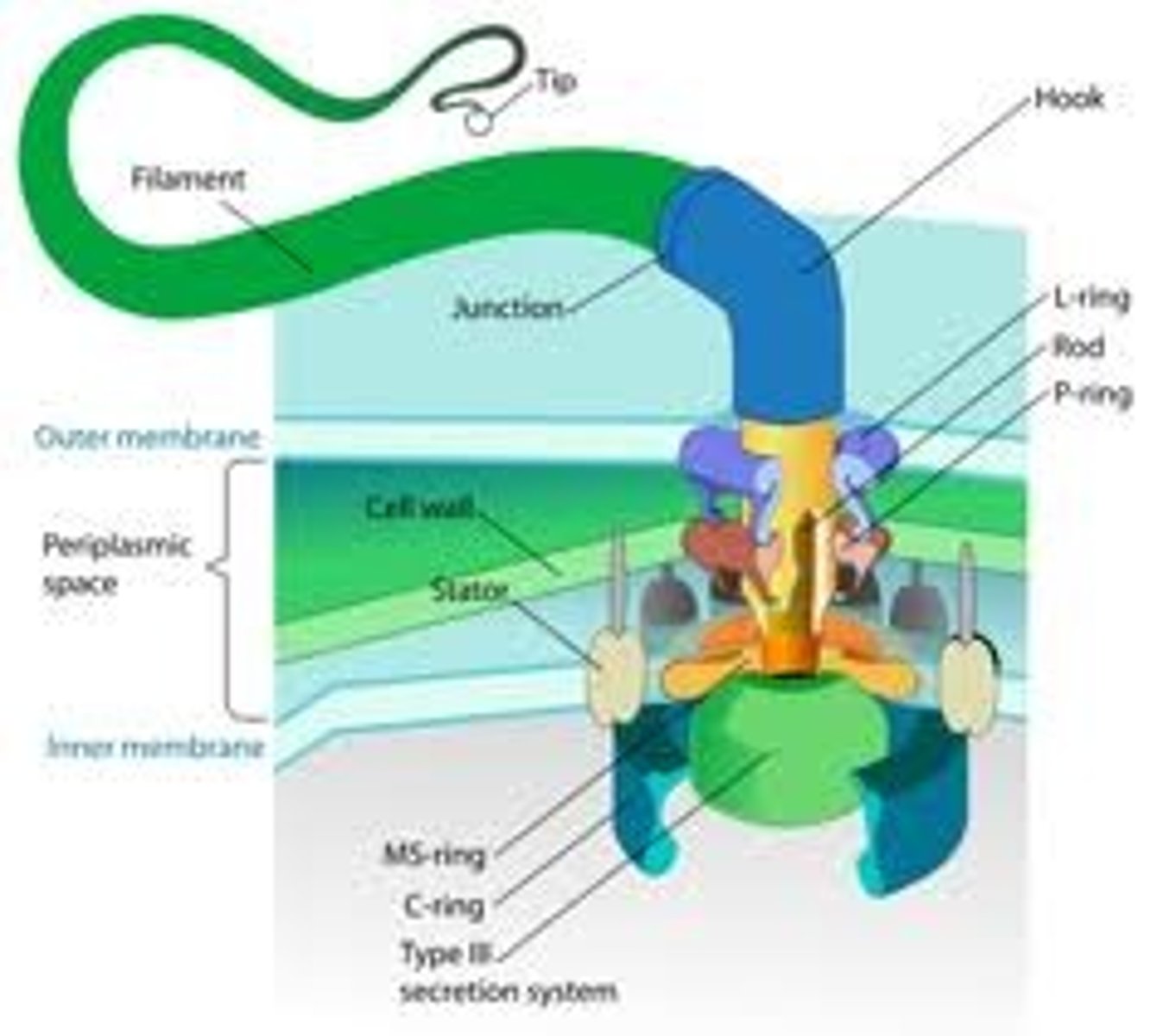
What does the basal body do?
Apart of the rotary "motor"; provides rotation. Consists of a central shaft surrounded by protein rings:
-2 in gram +
-4 in gram -
How does the rotation of the flagellar basal body occur?
Due to the proton motive force:
Where protons that accumulate on the outside of the cell membrane are driven through pores in the motor proteins, interacting with charges in the ring proteins as they pass across the membrane.
The interaction causes the basal body to rotate and turns the filament extending from the cell.
How fast can flagellar rotation occur?
200-1000 rpm
Bacterial Flagellar Movement:
Eukaryotes use what type of motion?
Whip-like motion
Bacterial Flagellar Movement:
Which direction is the flagella rotating if they are:
1. Tumbling?
2. Running?
1. Tumbling: Clockwise (CW)
2. Running(swimming): Counterclockwise (CCW)
If the bacterium is moving forward, it is: 1
If the bacterium is moving randomly, it is: 2
1. Forward: Running (swimming)
2. Random: Tumbling
Why do bacteria move?
They move towards something they want, and away from a repellant.
Water is like _____ to a microbe.
Molasses.
proton motive force
change in proton concentration across envelope; used to make ATP
How is the proton motive force generated? Where is PMF established?
PMF established within periplasmic space where there is a high concentration of protons within that space.
This sets up a charged pH gradient that sets up a strong potential energy relationship.
The cells will take advantage of PMF due to the amount of available energy by making ATP and driving the rotation of the flagellum.
Ions will travel through __________ to drive the motion of rotation of flagellum. They act as the channel to allow ions through.
motor proteins
Spirochetes utilize __________ motility due to their morphology and flagellar conformation.
They are effective for moving through ________ liquids.
1. Corkscrew-motility.
2. Viscous liquids.
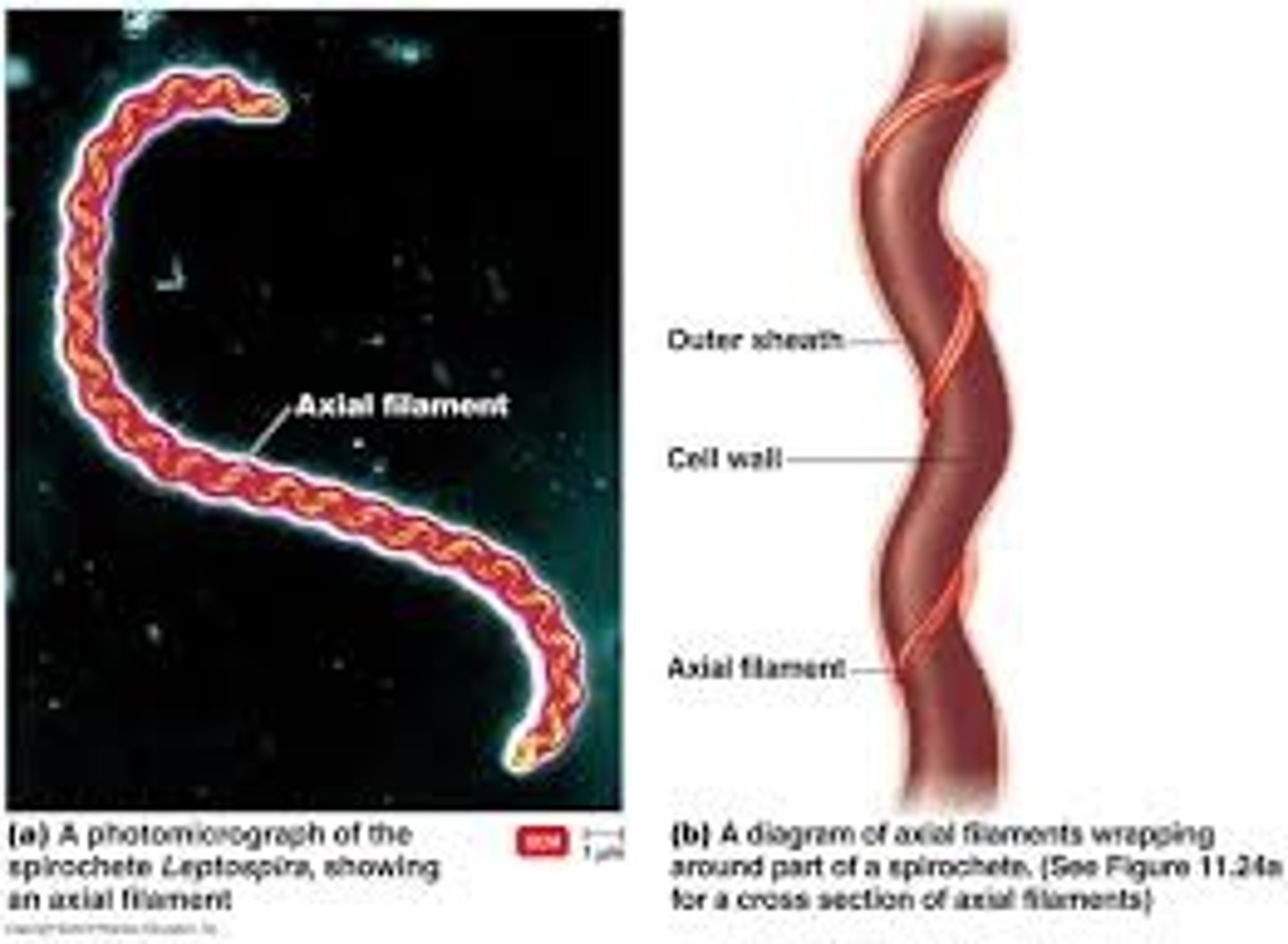
Spirochete: Axial Fibril
Multiple flagella arising from each end of a spirochete cell.
The flagella attaches to one end of the cell, extends back through the periplasm, and then attaches to the other end of the cell.

Twitching Motility
Only when cells are in contact with a surface or another cell.
They extend out a pillus and attach to something and pull themselves forward.
Extend and pull forward, extend and pull forward (as retracting pili).

Gliding motility
Smooth and varies in rate.
Exhibited by bacteria that do not require the use of flagella.
It does require that the cells be in contact with a solid surface.
Some cells rely on slime propulsion (from extracellular slime layer), where secreted slime propels the cell forward.
Other cells rely on surface layer proteins to pull the cell forward along peptidoglycan layer.
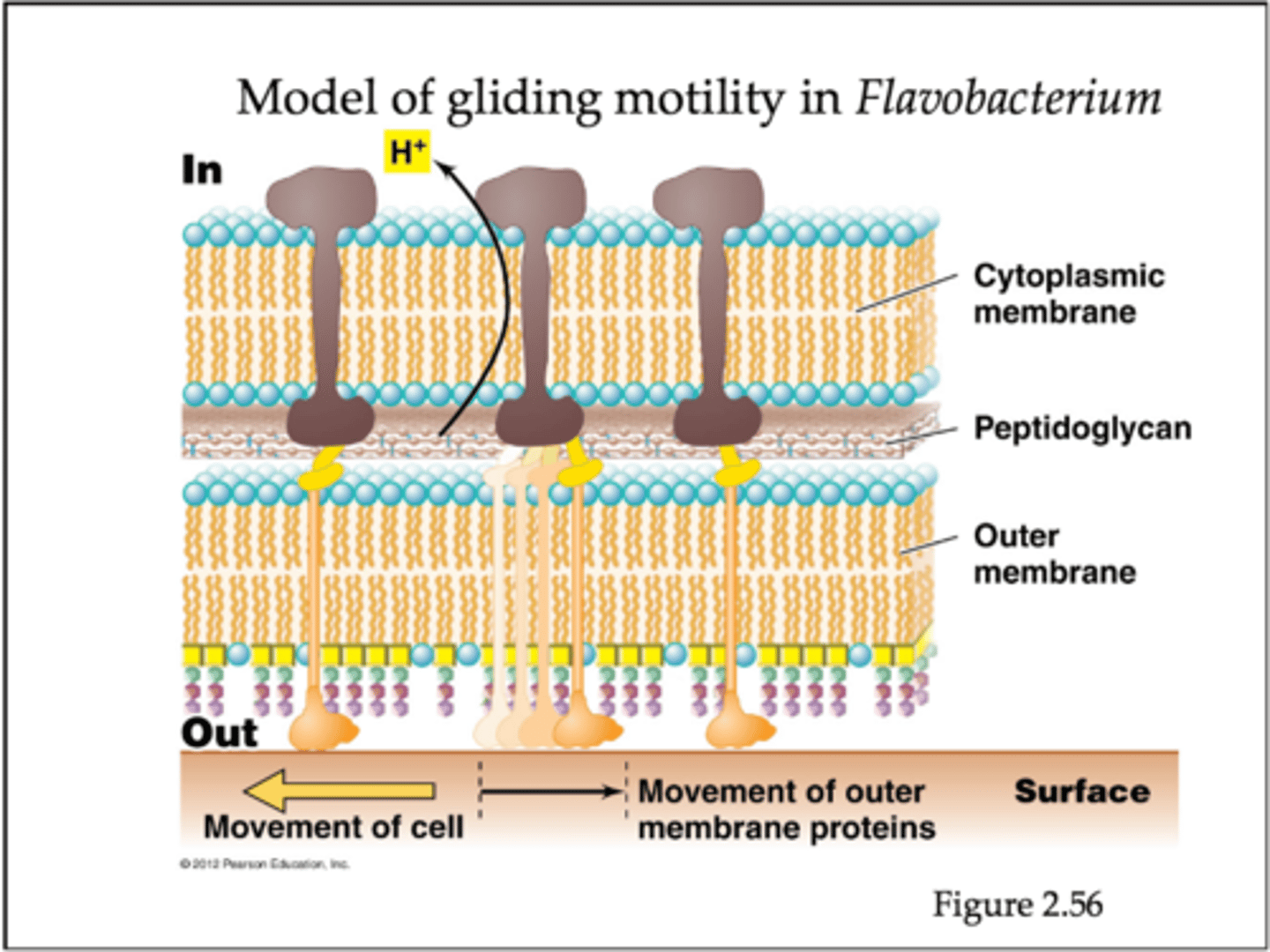
Chemotaxis and Phototaxis
Chemotaxis: Refers to movement of an organism towards or away from a chemical.
Phototaxis: Organism responds to light.
Chemotaxis: Absence of Attractant (or presence of Repellant)
vs
Presence of attractant (concentration gradient):
Absence of Attractant (Favorable substance): Shorter runs, longer tumbles. Random walk allows move up gradient of attractant, or down gradient of a repellant.
Presence of attractant (concentration gradient): Longer runs, shorter tumbling. Movements of cell change, resulting in movement towards attractant. They redirect each tumble and run towards attractant.
Chemical stimuli response: Attractants vs repellents
Attractants: Response at low levels
Repellants: Response at high levels

How does chemotaxis work?
Chemoreceptors (integral protein receptors embedded within membrane) on the cell surface bind molecules, transmitting a signal that influences the direction of flagellar rotation.
A conformational change translates the signal to motor direction.
Binding results in methylation or phosphorylation of chemoreceptor, triggering pathway.
-Kinase activity (phosphorylation)
-Methylation
Chemotaxis: Methylation vs Demethylation
Methylation: The cell moves towards higher concentration, adds methyl groups (good environments)
-Demethylating: Pulls methyl groups off when moving away.
Some bacteria exist in what two forms:
1. Vegetative: Actively growing, easily destroyed. They start here.
2. Endospore: Non-growing, resistant to heat, desiccation, chemicals, and UV light
-Formed during nutrient stress
-Soils most common
When are endospores formed?
When essential nutrients or water are not available (stress).
If bacteria are exposed to hostile conditions, they can convert from a _____ to a ____ cell if they have the ability.
The ______ is formed in the _______, and then the ________ lyses releasing the endospore.
1. Vegetative cell
2. Endospore
The endospore is formed in the vegetative cell, and then the vegetative cell lyses releasing the endospore.
How many endospores are there per cell?
One endospore per cell.
endospore structure (4):
1. exosporium: thin outer covering for chemical resistance
2. spore coat: several protein layers for chemical resistance and impermeable to chemicals
3. cortex: filled with spongy peptidolglycan missing tetrapeptide linkages.
Cortex is filled with Diplicolinic acid and calcium
4. core: dehydrated. Heat resistant and metabolically inactive.
Within core is small acid soluble proteins (SAPS) and alpha/beta types. These stabilize DNA and ribosomes and protect from desiccation, radiation, heat, and chemicals (these are chaperone proteins).
These all contribute to the cells resistance.
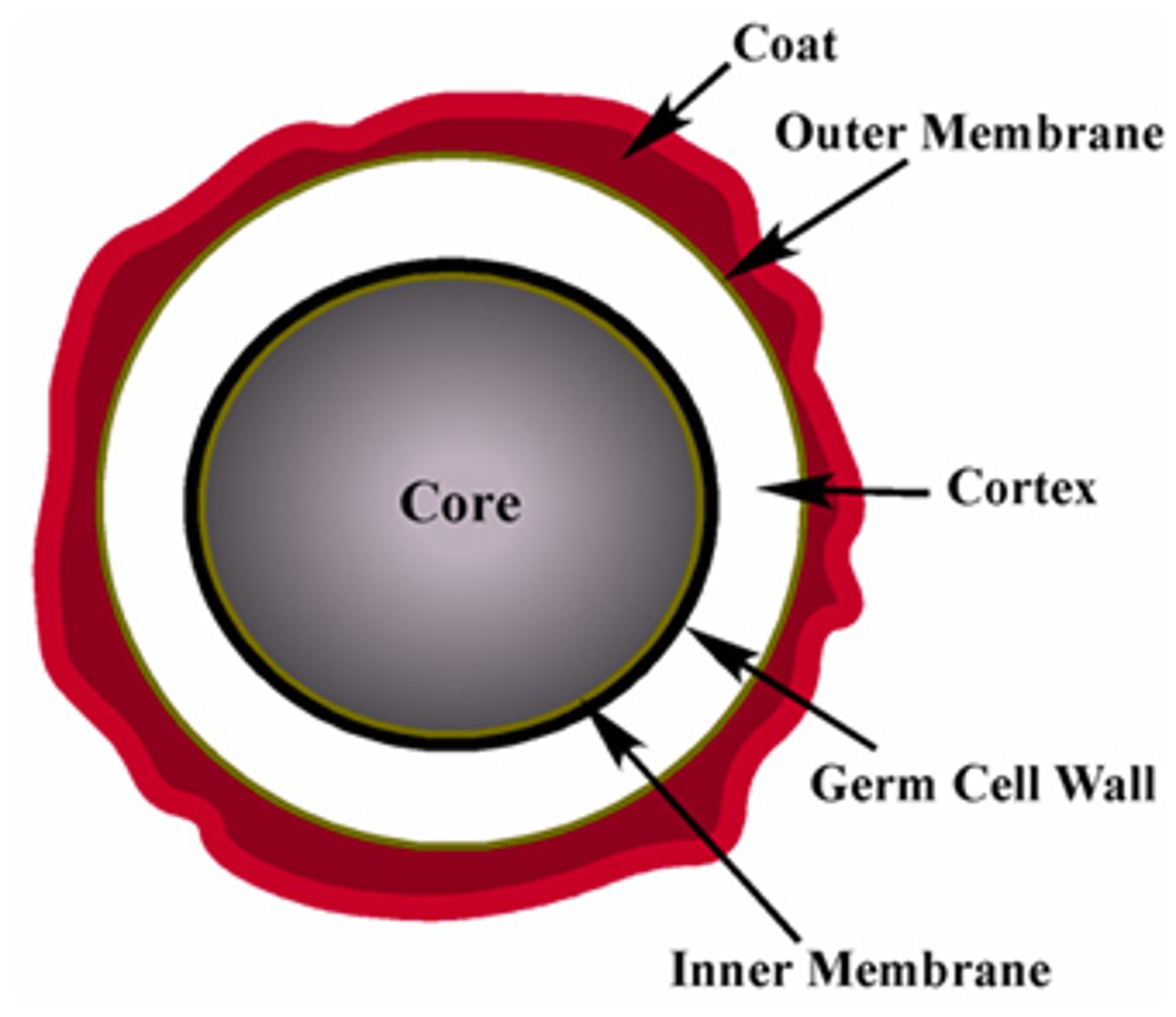
Endospore Sporulation
Triggered by unfavorable conditions.
1. DNA is replicated
2. DNA aligns along the cells long axis
3. Cytoplasmic membrane invaginates to form forespore
4. Cytoplasmic membrane grows and engulfs forespore within a second membrane. Vegetative cell's DNA disintegrates.
5. Cortex of calcium and diplicolinic acid deposited between membranes.
6. Spore coat forms around endospores.
7. Maturation of endospore; completing of spore coa and increase in resistance to heat and chemicals unknown process.
8. Endoposre released from original cell.
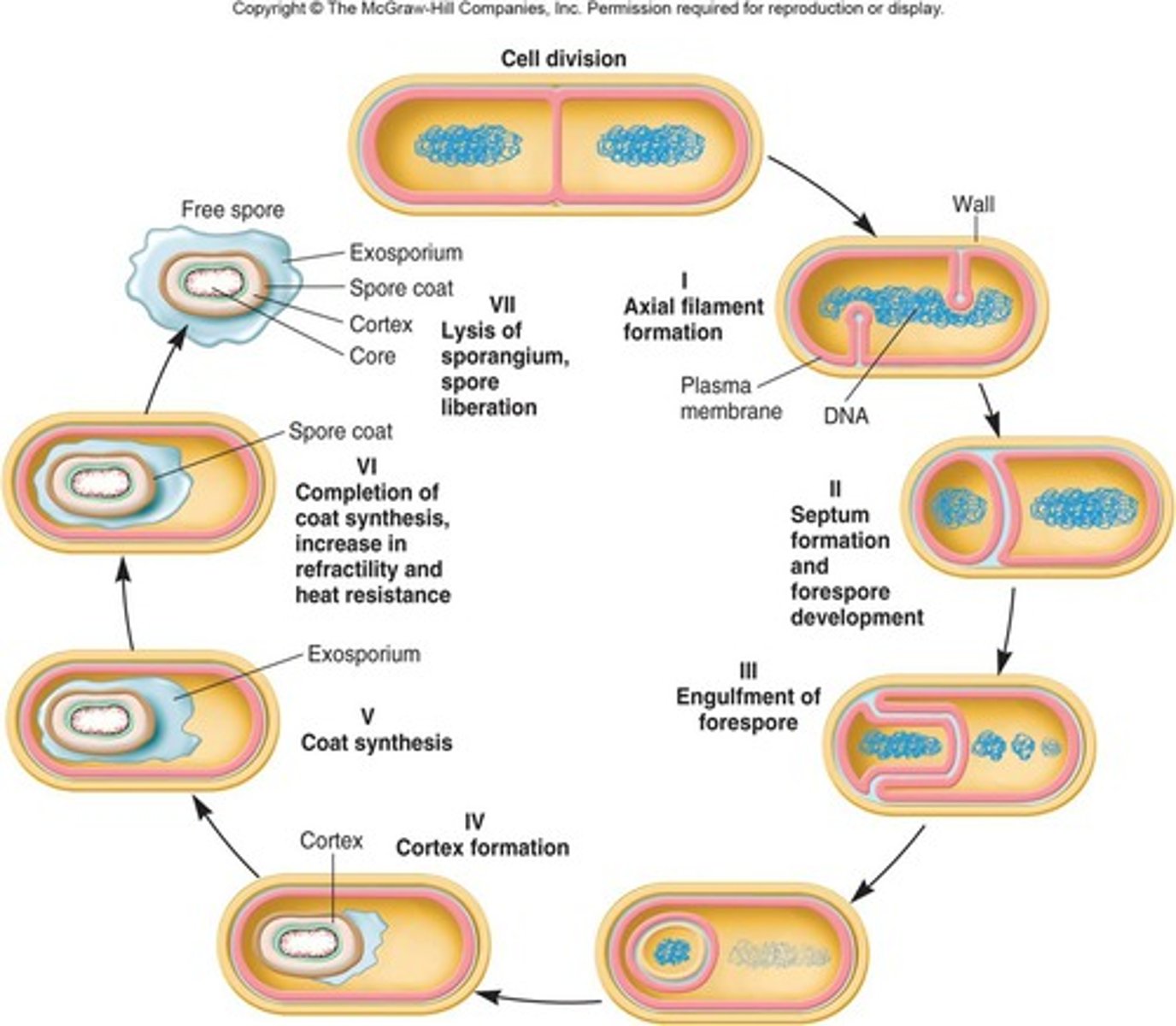
Endospore: Transformation of dormant spores into vegetative cells
1. Activation: Preparation step (reversible if not ready)
2. Germination: breaking of dormant state (irreversible) includes swelling from water, rupture of spore coat, and increase in metabolic activity.
3. Outgrowth: vegetative cell emerges from spore coat as a protoplast
Endospore: Protoplast
The vegetative cell that emerges from spore coat after outgrowth of endospore transformation
Bacterial Endospores:
Gram + bacteria (2)
1. Bacillus anthraxis
2. Clostridium botulinum
Porin Channel and small size that could get through
In outer membrane of gram negative
0.5 kD could get through a porin.
Viruses are ___________ meaning they cannot replicate outside their hosts
Obligate symbionts
Viruses can have _____ relationships with host
Mutualistic relationships
Viruses help with_______ because of their mutualistic relationships with their hosts.
Controlling host populations, controlling competition, and helping hosts adapt to environments.
Example: Human infected with herpes virus show suppression of HIV infections.
Size of Viruses
10nm (poliovirus--about the size of a ribosome) to 1 micrometer (Pandoravirus).
Virus Efficiency and make up
Small size, large surface area, Icosahedral.
They consist of nucleic acid surrounded by a protein coat (capsid).
Capsid is composed of smaller protein components called capsomers.
Virus Structures (3)
1. Helical: an elongated tube-like structure, with the capsomers arranged helically around the coiled genome.
2. Icosahedral: have a spherical shape, with icosahedral symmetry consisting of 20 triangular faces. The simplest icosahedral capsid has 3 capsomers per triangular face, resulting in 60 capsomers for the entire virus.
3. Complex: Brick shaped or tail fibers (poxvirus, bacteriophage)

capsomers
A subunit of the virus capsid shaped as a triangle or disc.
icosahedral capsid
Three-dimensional, 20-sided figure with 12 evenly spaced corners
Has 3 capsomers per face; 60 capsomers.
Capsid
Outer protein coat of a virus
Virus Envelopes
They are either naked or enveloped.
Envelop lipids and carbohydrates are derived from the host's nuclear or plasma membrane.
Envelop proteins are spikes or peplomers (viral proteins).
Spikes or Peplomers
glycoproteins on the envelope of a virus that project outward from the surface of the virion
Viral Enzymes: In capsid or envelope
1. Attachment
2. Viral release
3. Replication
Flu Virus
Flu vaccine is the mutation of flu virus.
Drifting: small changes
Shifting: major changes
Flu Spikes: why to get a vaccine every year
Spikes: Neuraminidase and hemagglutinin (proteins).
Viruses modify spikes on outside of cell by genetic mutation.
If virus has a drift, immune system can recognize it..
If virus has a shift, immune system cannot and the vaccine is not effective.
Virus can be _____ type of nucleic acid.
Any type! Single stranded RNA viruses are the focus.
1000 genome makes about _____ gene.
1 gene.
some viruses are super small (4000 genomes). Very efficient
Viruses will try to ______ to not work so hard.
Reduce the genome
Enzyme to copy DNA to make more DNA
DNA-Dependent DNA Polymerase: Copy DNA to make more of it.
DNA-dependent: what is being copied
DNA-polymerase: what is being made
Enzyme to copy DNA to make RNA
DNA-dependent RNA polymerase
Cell turns RNA to protein using a ______.
ribosome
where is virus DNA stored
In capsid
Virus steals DNA-dependent DNA polymerase from _____
Host cell.
Host provided DNA-dependent DNA polymerase.
Host encoded.
Virus needs _________ to make RNA from DNA
DNA-dependent RNA polymerase.
Host encoded.
Virus uses __________ to turn RNA into proteins
NO VIRUS ENCODES RIBOSOMES--encodes host and always steals ribosomes from host.
Cannot live without host-- obligate relationship.
RNA Virus: Needs to replicate its genome
RNA-> RNA
RNA-dependent RNA polymerase (aka replicase).
Encoded by virus ALWAYS since host cells never take RNA and make more RNA.
Not the same as host since it is going from RNA to RNA.
NEED TO KNOW WHAT IT IS USING AND WHO IS ENCODING IT. SEE NOTES IN NOTEBOOK.
Retrovirus
RNA to DNA (going backwards)
RNA-dependent DNA polymerase.
Virus encodes since host cell NEVER goes backwards.
An RNA virus that reproduces by transcribing its RNA into DNA and then inserting the DNA into a cellular chromosome; an important class of cancer-causing viruses.
Retrovirus encodes
RNA dependent RNA polymerase and reverse transcriptase
AKA
Replicase and reverse transcriptase
dsRNA vs dsDNA
dsRNA: Are very tightly wound. Requires higher melting temp to unwind vs dsDNA
When dsRNA is duplicated or expressed, it must get unwound to get copied.
The unwinding process is a helicase.
The same dsDNA helicase will not work on dsRNA.
Central Dogma of Molecular Biology
DNA -> RNA -> Protein
Viral process (adsorption, entry, nucleic acid replication, protein expression, assembly, release)
1. Adsorption (Attachment): Attachment of virus to specific host receptors via viral ligands.
-Host receptors: lipopolysaccharides, proteins, teichoic acids, flagella, pili
-Receptor specificity
2. Entry: Entrance for genome or entire nucleocapsid
-Bacteriophage: inject nucleic acid only
-Eukaryotic viruses 3 different modes:
--Fusion of viral envelop with host cell membrane
--Receptor-mediated endocytosis (endosome)
--Nucleic acid injection
3. Nucleic acid replication: Production of viral nucleic acid. Dictated by viral genome.
--dsDNA Most similar to host. Uses host DNA polymerase and RNA polymerase.
4. Protein expression: Tightly regulated.
-Early proteins: Expressed early in infection. Used for replicating proteins. Phage DNA synthesis: shuts off host DNA, RNA, and protein biosynthesis (lytic virus). In some cases, degradation of host chromosome.
-Late proteins: Expressed late in infection. Structural proteins (nuclear capsids); responsible for lysis of host cell to get out.
5. Assembly
6. Release: Exit to environment via lysis of host cell. Lysozyme (viral protein) attacks peptidoglycan.
--Budding: Common in enveloped viruses; viral proteins inserted into host membrane. Host cell not lysed--just leaks out viruses.
--Cell to cell transfer
SEE FIG 6.14 IN BOOK
Virus release: budding
Common in enveloped viruses; viral proteins inserted into host membrane. Host cell not lysed--just leaks out viruses.
late proteins
structural capsids; lysis of host cell
Bacteriophages produce
Lysozyme that chops up peptidoglycan
Lysozyme
An enzyme that destroys bacterial cell walls; in mammals, found in sweat, tears, and saliva.
Chops peptidoglycan
Virus nucleases
Chop up host genetic material but is different than their own so they do not chop themselves up
RNA virus strategies
RNA-> RNA
-RNA-dependent RNA polymerase
RNA->DNA
-RNA-dependent DNA polymerase (reverse transcriptase)
dsRNA
-viral encoded helicase
RNA Helicase
Unwinds tight dsRNA virus. Cannot use dsDNA helicase; must be dsRNA helicase.
How does a virus regulate?
Early and late proteins expressed early or late in infection.
Bacterial phage types
Lytic phage
Temperate phage
lytic phage
Replicates and goes out to find new host.
Ligand receptor match; injects host cell (prophage), lysis and finds another host.
Prophage
Genetic material injected into host cell
temperate phage: either lytic or lysogenic
Either multiply like virulent phages and lyses host cell, or remains within cell without destroying it.
They can do this by integrating their genome in the host cell's chromosome.
Allow viruses to be dormant in host.
Preserve host cell population.
Lysogenic conversion
The prophage is now expressing genes that alters outside of host cell.
Prevents other viruses from entering cell.
Induction
UV Light induces change in prophage to move into lytic cycle.
Upon induction, prophage gets clipped out of host cell and begins expressing late proteins.
Temperate phages can be
lytic or lysogenic
Temperate Phage events in order:
1. Viral Ligand: host receptor recognition
2. Formation of prophage
3. Lysogenic conversion
4. Induction
5. Viral capsid formation
6. Lysozyme production
What do all RNA viruses need?
Needs host ribosomes and needs virus encoded RNA-dependent RNA polymerase
Eukaryotic infections
1. Acute infection causes cell lysis
2. latent infection
3. chronic infection: slow release of virus without lysis
4. transformation into malignant cell
2,3 : viral components present, host not harmed
2, 3, 4: often cause cytophathic effects
Oncogenes:
genes involved in carcinogensis
proto-oncogenes
normal host gene required for growth. integration of viral DNA causes mutation or over-expression,
Virus causing cancer and HPV.
Name genes that control cell division and how HPV virus interrupts that.
Interfere with two key genes present in host cells:
1. p53
2. Rb
Both control cell subdivision. This causes uncontrolled cell division.
HPV (only 8000 base pairs; 8 genes).
E6 binds p53
E7 binds Rb
Cell division not regulated.
How does HPV vaccine work
Mimics capsid proteins of HPV.
oncoviruses
viruses that cause cancer
p53 and Rb
Tumor supressor proteins:
p53 controls host cell cycle and initiates cycle arrest or programmed cell death in response to DNA damage
Rb regulates cell cycling.
Osmoregulation
regulation of solute concentrations and water balance by a cell or organism
isotonic vs hypertonic vs hypotonic solution
Note: Check to see if it is the solution or the cell that gradient is referring to.
Isotonic Solution: Equal concentrations; no net movement of water in or out of the cell
Hypertonic Solution: Water moves out of the cell due to concentration being higher outside of cell.
Hypotonic Solution: Water moves inside the cell due to concentration gradient being higher inside of cell. This could cause lysis.
How do cells adjust to hypotonicity?
Mechanosensitive channels inside cell envelope that move concentration of solutes from inside cell to outside of cell.
Build up of pressure from high concentration of solutes that creates tension on envelope and wall, and these channels open up that allow for removal and movement of solutes outside of cell.
Cell wall maintains what? and in what environemnt?
Structural integrity and hypotonic
Cell is always slightly _____ in cell.
Hypertonic inside of cell than environment.
This keeps a slight pressure on cell wall.
Perfect isotonic doesn't exist.
Cell needs membrane pressed up against wall to maintain continuity in cell envelope to keep strong proton motive force.
Hypertonic: Osmolytes
Any inorganic or organic solute whose concentration is adaptively regulated during the process of cell volume regulation, in parallel with the osmotic stress imposed on the cell.
Osmolytes are important for what of proteins?
Keep proteins from denaturation!
Major classes of hypertonic osmolytes (4)
Urea
Sugars and polyhydric alcohols
Amino acids and amino acid derivatives
Methylated ammonium and sulfonium compounds
Important transporters that allow compounds and water in/out imbedded into envelope.
Porins and aqua porins maintain osmoregulation by moving compounds and osmolytes.
Hypertonic Environments (adaption to extreme hypertonic environments)
Halophiles, Extreme halophiles, halotolerant, Neutrophiles, Alkaliphiles, psychrophile, psychrotroph, mesophile, microaerophiles
Halophiles
"salt-loving" archaea that live in environments that have very high salt concentrations.
Must have salt environment.
extreme halophiles
An organism that lives in a highly saline environment, such as the Great Salt Lake or the Dead Sea.
Halotolerant
Can survive at higher salt concentrations but grow best at low or zero concentrations
Ex: Staphylococcus aureus